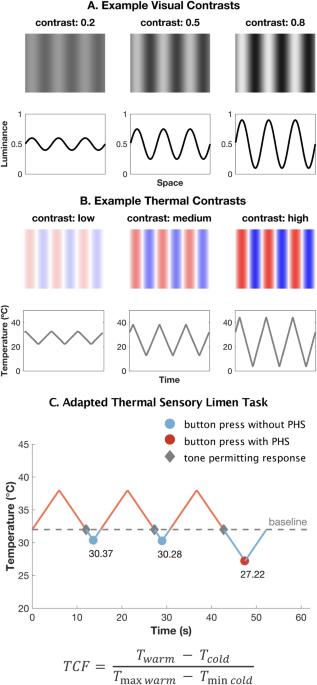Thermal contrast enhancement predicts paradoxical heat sensation
引用次数: 0
Abstract
Paradoxical Heat Sensation (PHS) is the remarkable feeling of warmth or heat pain while the skin is cooling. Despite its initial documentation over 100 years ago, a unified explanation for this perplexing experience remains elusive. Here we apply contrast enhancement principles, known for their instrumental role in understanding visual illusions, to the domain of thermosensation. Contrast enhancement describes the amplification of two contrasting visual features, such as the enhanced perception of an edge between a light and dark bar. In thermosensation, this encompasses an enhancement of the difference between sequential warming and cooling of the skin, and is defined as the normalised difference between successive temporal warm and cold temperatures. Remarkably, thermal contrast predicts the occurrence of PHS. Our findings reveal compelling evidence supporting the role of thermal contrast in the generation of PHS, shedding light on its underlying mechanism and offering a framework for broader encoding principles in thermosensation and pain. Applying contrast enhancement principles, established within the visual and auditory domain, to thermosensation, reveals that larger temporal contrasts increase the probability of experiencing thermal nociceptive illusions.

热对比增强可预测矛盾热感
反常热感(PHS)是指在皮肤冷却时却有明显的发热或热痛感觉。尽管早在 100 多年前就有文献记载了这种令人困惑的体验,但至今仍未找到统一的解释。在此,我们将对比度增强原理应用于热感觉领域,该原理因其在理解视觉错觉方面的重要作用而闻名。对比增强描述的是两种对比强烈的视觉特征的放大,例如明暗条纹之间的边缘感知增强。在热感觉中,这包括皮肤连续升温和降温之间差异的增强,并被定义为连续时间性冷热温度之间的归一化差异。值得注意的是,热对比能预测 PHS 的发生。我们的研究结果揭示了令人信服的证据,支持热对比在 PHS 发生中的作用,揭示了其潜在机制,并为热感觉和疼痛中更广泛的编码原理提供了一个框架。将在视觉和听觉领域建立的对比度增强原理应用于热感觉,可以发现较大的时间对比度会增加出现热痛觉幻觉的概率。
本文章由计算机程序翻译,如有差异,请以英文原文为准。
求助全文
约1分钟内获得全文
求助全文

 求助内容:
求助内容: 应助结果提醒方式:
应助结果提醒方式:


